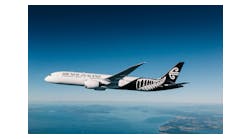A consortium of European air navigation service providers and airlines has recently been formed to explore optimised descent profiles (ODP) from upper airspace to terminal manoeuvring areas. The goal is to improve vertical flight efficiency and environmental sustainability while also considering capacity aspects.
Following free route projects and continuous descent operations at numerous airports, the focus for optimisation now lies on the route segment between cruising altitude and the terminal manoeuvring areas around airports.
The air navigation service providers of Germany (DFS Deutsche Flugsicherung), Austria (Austro Control), France (DSNA) and Switzerland (Skyguide), as well as EUROCONTROL’s Maastricht Upper Area Control Centre (MUAC) aim to develop optimised descent procedures for certain approach paths to the airports of Basel, Berlin-Tegel, Frankfurt, Geneva, Munich, Strasbourg, Stuttgart, Vienna and Zurich.
The project will conduct fast-time and real-time simulations as well as several cross-border exercises, developing continuous descent profiles at the highest level possible for aircraft coming from both free route and conventional route airspaces. Cross-centre arrival management systems (XMAN) and their applicability in the context of continuous descent operations will also be examined.
The results will be verified by test flights in cooperation with the airline operators and consortium members Air France, Deutsche Lufthansa, SWISS and their affiliated airlines (among them HOP!, Austrian Airlines, Germanwings).
The consortium, which is under the lead of DFS, is co-funded by the SESAR Joint Undertaking. The final project results are expected to be available by September 2016.
SESAR: ODP is one of several SESAR demonstration activities co-funded by the SESAR Joint Undertaking, the public-private partnership that pools the knowledge and resources of the entire European air traffic management community to deliver solutions for a modernised ATM, enabling highly efficient aviation in Europe. To date, more than 30,000 flight trials have been conducted providing concrete and tangible evidence of the benefits offered by SESAR solutions in day-to-day operations.
XMAN: The abbreviation stands for cross-centre arrival management. Information from the arrival management system (AMAN), which had only been available to the air traffic controllers in approach control, is displayed at upstream control centres. The planning process extends to a radius of up to 200 nautical miles. Aircraft can be brought into an optimal approach sequence much earlier and holdings can be avoided.
For more information please contact:
DFS Deutsche Flugsicherung GmbH (consortium leader)
Nanda Geelvink, phone: +49 (0) 6103 - 707 - 4164, e-mail: [email protected]
DFS Deutsche Flugsicherung GmbH, the German air navigation service provider, is a State-owned company under private law with 5,881 employees as at 31 December 2014. DFS ensures the safe and punctual flow of air traffic over Germany. Around 2,000 air traffic controllers guide up to 10,000 flights in German airspace every day, and about three million movements every year. This makes Germany the country with the highest traffic volume in Europe. The company operates control centres in Langen, Bremen, Karlsruhe and Munich as well as 16 control towers at international airports in Germany. In addition, DFS is represented at the EUROCONTROL Control Centre in Maastricht, the Netherlands. Additional areas of activity include consulting, provided by the Aeronautical Solutions Division, and aeronautical data, grouped in the Aeronautical Information Management Division.




